La Raza are the people of the Hispanic and Chicano world.
Contents
La Raza may also refer to:
La Raza are the people of the Hispanic and Chicano world.
La Raza may also refer to:
Metro, short for metropolitan, may refer to:
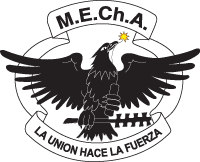
M.E.Ch.A. is a US-based organization that seeks to promote Chicano unity and empowerment through political action. The acronym of the organization's name is the Chicano word mecha, which is the Chicano pronunciation of the English word match and therefore symbolic of a fire or spark; mecha in Spanish means fuse or wick. The motto of MEChA is 'La Union Hace La Fuerza'.

KLAX-FM is an American commercial radio station located in East Los Angeles, California, broadcasting to the Greater Los Angeles area. It is owned by Spanish Broadcasting System (SBS). KLAX-FM airs a regional Mexican music format branded as "La Raza". The station has studios in Los Angeles, and its transmitter is based in Glendale.

The Brown Berets is a pro-Chicano paramilitary organization that emerged during the Chicano Movement in the late 1960s. David Sanchez and Carlos Montes co-founded the group modeled after the Black Panther Party. The Brown Berets was part of the Third World Liberation Front. It worked for educational reform, farmworkers' rights, and against police brutality and the Vietnam War. It also sought to separate the American Southwest from the control of the United States government.

The Royal Chicano Air Force (RCAF) is a Sacramento, California-based art collective, founded in 1970 by Ricardo Favela, José Montoya and Esteban Villa. It was one of the "most important collective artist groups" in the Chicano art movement in California during the 1970s and the 1980s and continues to be influential into the 21st century.
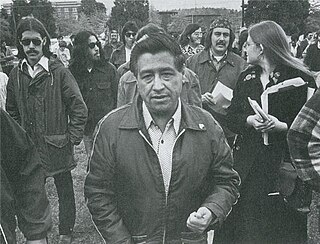
The Chicano Movement, also referred to as El Movimiento, was a social and political movement in the United States that worked to embrace a Chicano/a identity and worldview that combated structural racism, encouraged cultural revitalization, and achieved community empowerment by rejecting assimilation. Chicanos also expressed solidarity and defined their culture through the development of Chicano art during El Movimiento, and stood firm in preserving their religion.

The Centro Cultural de la Raza is a non-profit organization with the specific mission to create, preserve, promote and educate about Chicano, Mexicano, Native American and Latino art and culture. It is located in Balboa Park in San Diego, California. The cultural center supports and encourages the creative expression “of the indigenous cultures of the Americas.” It is currently a member of the American Alliance of Museums.
Gilbert "Magu" Luján was a Chicano American sculptor, muralist, painter, and educator. He was a founding member of the Chicano collective, Los Four that consisted of artists Carlos Almaraz, Beto de la Rocha, Frank Romero and himself. In 1974, Judithe Hernández became the "fifth member," and only female member of Los Four.

The Spanish expression la Raza has historically been used to refer to the mixed-race populations, considered as an ethnic or racial unit historically deriving from the Spanish Empire, and the process of racial intermixing during the Spanish colonization of the Americas with the indigenous populations of the Americas.
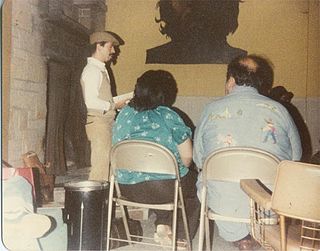
Alberto Baltazar Urista Heredia, better known by his nom de plume Alurista, is an American poet and activist. His work was influential in the Chicano Movement and is important to the field of Chicano poetry.

Juan Felipe Herrera is an American poet, performer, writer, cartoonist, teacher, and activist. Herrera was the 21st United States Poet Laureate from 2015 to 2017. He is a major figure in the literary field of Chicano poetry.
Rubén Ortiz Torres is a Mexican photographer, painter, sculptor, film and video producer.
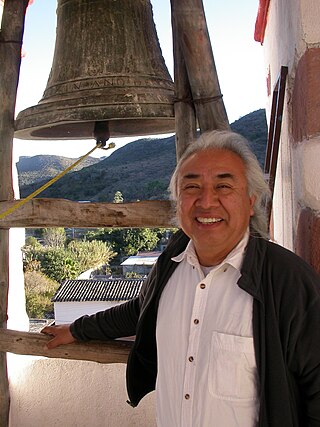
Hugo Noé Morales is the executive director and co-founder, in 1976, of Radio Bilingüe Inc., the national Latino public radio network. He is responsible for leading and managing all aspects of organizational development and service delivery for this non-profit organization whose mission is to serve as a voice to empower Latino and other underserved communities. Radio Bilingue is a transnational satellite community radio service in Spanish, English and Mixtec. Other responsibilities include: program development, public relations, fundraising, board development, personnel management, and key stakeholder management.
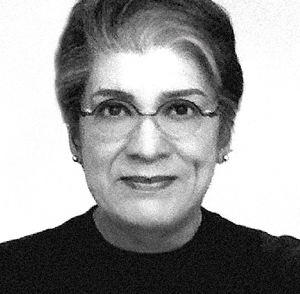
Judithe Hernández is an American artist and educator, she is known as a muralist, pastel artist, and painter. She is a pioneer of the Chicano art movement and a former member of the art collective Los Four. She is based in Los Angeles, California and previously lived in Chicago.

The Chicano Art Movement represents groundbreaking movements by Mexican-American artists to establish a unique artistic identity in the United States. Much of the art and the artists creating Chicano Art were heavily influenced by Chicano Movement which began in the 1960s.
Victor Ochoa is an activist, painter, graphic designer and master muralist. He has painted over 100 murals, many of them in San Diego, California. He is considered one of the pioneers of San Diego's Chicano art movement. Ochoa was one of the original activists at Chicano Park and a co-founder of Centro Cultural de la Raza in Balboa Park, both in San Diego. He helped establish the influential Border Art Workshop/Taller de Arte Fronteriza (BAW/TAF). Ochoa is also a teacher of art and Chicano heritage. His work has been shown nationally and internationally, including at the Venice Bi-Annual, at the Museum of Contemporary Art, San Diego and in the groundbreaking exhibition, Chicano Art: Resistance and Affirmation (CARA). In addition to creating his own work, he is also a master of art preservation techniques, especially relating to murals. He is considered to be a "serious cultural resource in the border region.
ChismeArte was an avant-garde Chicano magazine published by the LA Latino Writers Association (LALWA) and produced by the Concilio de Arte Popular, a California statewide arts advocacy group of Chicano arts organizations headed by Manazar Gamboa. The magazine began publication in 1976. It was produced by Guillermo Bejarano in the early 1980s. Manazar Gamboa served as Director of LALWA and Editor of ChismeArte from 1981-1983. Organizational members of the People's Art Council included The Teatro Campesino in San Juan Bautista, The Royal Chicano Air Force in Sacramento, Mechicano Art Center in Los Angeles, and The Galeria de la Raza and The Mexican Museum in San Francisco, and The Centro Cultural de la Raza in San Diego.

A Mexican American is a resident of the United States who is of Mexican descent. Mexican American-related topics include the following:

The Monumento a la Raza is a 50 meters (160 ft) high pyramid in northern Mexico City. It is located in the intersection of Avenida de los Insurgentes, Circuito Interior and Calzada Vallejo, in the Cuauhtémoc borough.
Ralph Maradiaga (1934–1985) was an American artist, curator, photographer, printmaker, teacher, and filmmaker. He was Chicano, one of the co-founders of Galería de la Raza and part of the San Francisco Bay Area Chicano Art Movement.